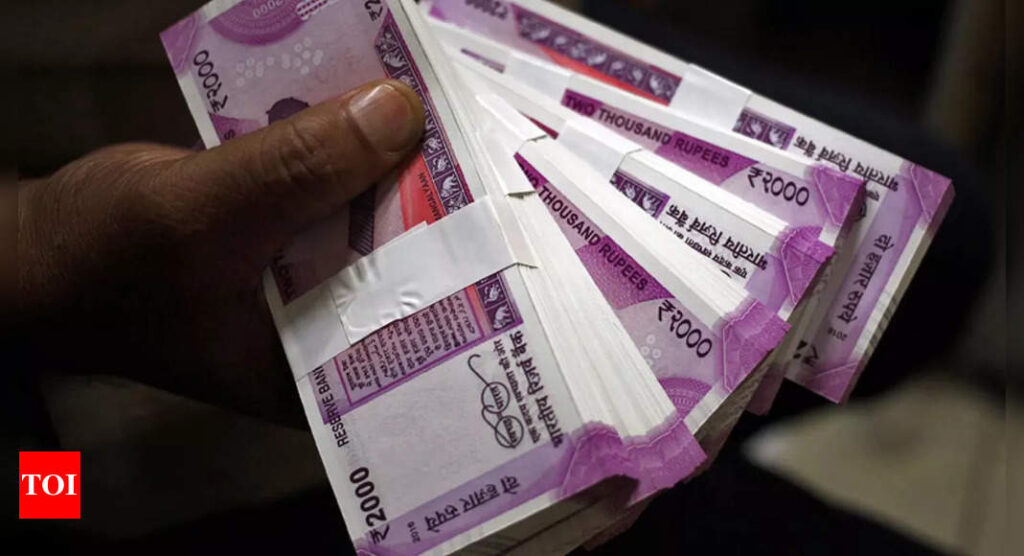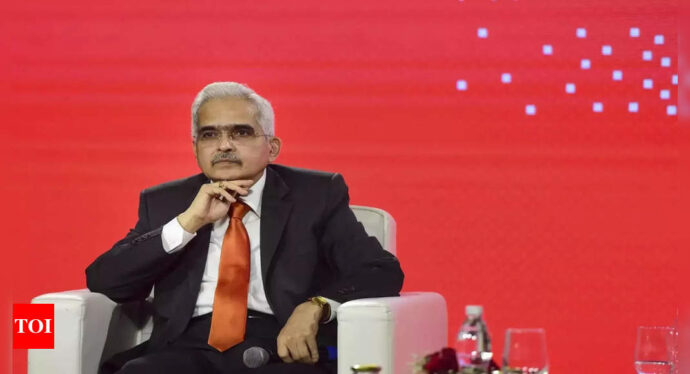Why rupee touched an all time low of 80.13 to the US dollar today – Times of India

[ad_1]
NEW DELHI: The rupee breached the 80-to-a-dollar mark to hit a fresh record low of 80.13, while the US dollar surged to a 20-year high against a basket of currencies on Monday after Federal Reserve Chair Jerome Powell signalled interest rates would be kept higher for longer to bring down soaring inflation.
Domestic equities also fell with Sensex falling over 1,200 points, tracking a global selloff. Asian equities were also in the red, tracking the Friday’s selloff on Wall Street. The S&P 500 Index plunged 3.4% on Friday and futures indicated another 1% fall for the US gauge.
US Fed Chair Powell reiterated the central bank’s unconditional commitment to tackle inflation, besides highlighting risks posed by elevated and extended periods of high price growth. Powell made it clear that the central bank’s fight against inflation was not over and Fed was likely to keep raising interest rates to stamp out inflation.
At the Jackson Hole Economic Symposium on Friday, Powell said that “restoring price stability will likely require maintaining a restrictive policy stance for some time. The historical record cautions strongly against prematurely loosening policy.”
The dollar index, which tracks the movement of the greenback against a basket of six major world currencies, rose 0.47 per cent to 109.31 level. The previous lifetime low for the rupee was 80.06 per dollar on July 19. The index has strengthened more than 14 per cent so far in 2022 while the Indian rupee has weakened a little more than 7 per cent in 2022.
“In forex pack, US dollar index tested 20-year high, Euro and Pound fell near their record lows. Asian currencies are trading with a loss of 0.30%- 0.50%. The Yuan tested a 2-year low. The likely range for USD-INR for the day would be 79.70 to 80.30,” CR Forex Advisors said in a note.
So, why did the rupee fall to a life low while the dollar gained?
“The rupee is under pressure in today’s trading session due to the hawkish commentary of the Fed chairman announced at the Jackson Hole Economic Policy Symposium. The fight to tame inflation is expected to continue in the distant future and the rate hikes are expected to put pressure on the rupee and other emerging market currencies. However, due to the better-than-expected economic growth trajectory of India and less severity of inflation compared to its peers, INR has fared better than other currencies… the rupee might bottom out at around 80.5 to 81 levels,” said Santosh Meena, Head of Research, Swastika Investmart Ltd.
The message from the world’s top finance chiefs is loud and clear: rampant inflation is here to stay and taming it will take an extraordinary effort, most likely a recession with job losses and shockwaves through emerging markets.
The US central bank has already hiked its key overnight interest rate four times this year to control the worst inflation in decades. Higher interest rates increase the opportunity cost of holding non-yielding bullion, while boosting the dollar. The pain of high US rates will reverberate well beyond the nation’s economy and hit emerging markets hard, especially if high rates prove as lasting as Powell now signals.
Many emerging market countries borrow in dollars and higher Fed rates hit them on multiple fronts.
It pushes up borrowing costs and raises debt sustainability issues. It also channels liquidity to the U.S. markets, pushing up emerging market risk premiums, making borrowing even more difficult.
Lastly, the dollar will keep firming against most currencies, pushing up imported inflation in emerging markets.
The sharp rise in the Dollar index above 109 and the 10-year bond yield spiking to 3.1 % are negative for capital flows to emerging markets like India as foreign portfolio investors are unlikely to continue buying in India in this scenario. As money flows out of India, the rupee-dollar exchange rate gets impacted and the rupee depreciates further. Such depreciation puts considerable pressure on the already high import prices of crude and raw materials, paving the path for higher imported inflation and production costs besides higher retail inflation.
The depreciating trend in the Indian rupee is in sync with other emerging economies’ currencies. With continued uncertainty surrounding the Russia-Ukraine war, capital is flowing to safe havens like the US, which is why the dollar has been strenghtening.
According to a note by Nomura, Indian equities have already experienced $28.9 billion of net foreign outflows year-to-date in July, the second most among Asian economies, excluding Japan.
“A major part of the rupee correction is due to the interest rate differential between India and the USA and the potential of further rate increases in the USA over the coming months, as the Fed Chair had represented a hawkish stance in his speech last weekend. The consensus says that the interest rates in the USA are expected to cross 2.75% in this quarter,” said Divam Sharma, Founder at Green Portfolio, SEBI Registered Portfolio Management Service Provider
A rate hike in the US will lower investment returns for foreign investors in India and prompt them to sell. Barring long-term FPIs, other foreign investors prefer short-term trade without hedging. A volatile currency often forces them to hedge, lowering their returns. Firms that have borrowed heavily in dollars in the overseas market may see higher cost on borrowings.
“USDINR is on a strong wicket, with such a positive USD backdrop. A strong US Dollar Index, high US bond yields with an deeply inverted yield curve and weak equity markets all makes it challenging for FPI and carry trade flows in EMs. However, the speed of the up move will be closely regulated by RBI. RBI has twin objectives of not letting the Rupee become a weak outlier and also, they do not want the USDINR to become too volatile. This means they may continue to sell USD as the spot and forwards moves to a fresh all-time high. However, this may not alter the trajectory of the pair and the path of least resistance would remain upward. We expect a range of 79.70 and 80.50 over the next 1-2 weeks,” said Anindya Banerjee, VP, Currency Derivatives & Interest Rate Derivatives at Kotak Securities.
And with global capital flows drying up in a US Fed tightening cycle, and India’s external balances becoming challenging, the rupee is likely to feel further downward pressure in the near-term. Goldman Sachs forecasts the rupee to trade at 80-81 per dollar over the next 3 to 6 months.
What does this mean for India’s monetary policy?
“The US Federal reserve chairman has reiterated his blueprint of raising coupon rates in America which means the US will attract investments In their homeland. That pressurises other nations to raise interest rates as well. This is to keep attracting FII inflows on a cash-carry (interest rate arbitrage) onsideration. The forex and bond markets are collectively indicating expectation from the forthcoming monetary policy committee meeting to raise rates in India as well,” said Vijay Bhambwani, Head of Research- Behavioral Technical analysis at Equitymaster.
(With inputs from Reuters)
Domestic equities also fell with Sensex falling over 1,200 points, tracking a global selloff. Asian equities were also in the red, tracking the Friday’s selloff on Wall Street. The S&P 500 Index plunged 3.4% on Friday and futures indicated another 1% fall for the US gauge.
US Fed Chair Powell reiterated the central bank’s unconditional commitment to tackle inflation, besides highlighting risks posed by elevated and extended periods of high price growth. Powell made it clear that the central bank’s fight against inflation was not over and Fed was likely to keep raising interest rates to stamp out inflation.
At the Jackson Hole Economic Symposium on Friday, Powell said that “restoring price stability will likely require maintaining a restrictive policy stance for some time. The historical record cautions strongly against prematurely loosening policy.”
The dollar index, which tracks the movement of the greenback against a basket of six major world currencies, rose 0.47 per cent to 109.31 level. The previous lifetime low for the rupee was 80.06 per dollar on July 19. The index has strengthened more than 14 per cent so far in 2022 while the Indian rupee has weakened a little more than 7 per cent in 2022.
“In forex pack, US dollar index tested 20-year high, Euro and Pound fell near their record lows. Asian currencies are trading with a loss of 0.30%- 0.50%. The Yuan tested a 2-year low. The likely range for USD-INR for the day would be 79.70 to 80.30,” CR Forex Advisors said in a note.
So, why did the rupee fall to a life low while the dollar gained?
“The rupee is under pressure in today’s trading session due to the hawkish commentary of the Fed chairman announced at the Jackson Hole Economic Policy Symposium. The fight to tame inflation is expected to continue in the distant future and the rate hikes are expected to put pressure on the rupee and other emerging market currencies. However, due to the better-than-expected economic growth trajectory of India and less severity of inflation compared to its peers, INR has fared better than other currencies… the rupee might bottom out at around 80.5 to 81 levels,” said Santosh Meena, Head of Research, Swastika Investmart Ltd.
The message from the world’s top finance chiefs is loud and clear: rampant inflation is here to stay and taming it will take an extraordinary effort, most likely a recession with job losses and shockwaves through emerging markets.
The US central bank has already hiked its key overnight interest rate four times this year to control the worst inflation in decades. Higher interest rates increase the opportunity cost of holding non-yielding bullion, while boosting the dollar. The pain of high US rates will reverberate well beyond the nation’s economy and hit emerging markets hard, especially if high rates prove as lasting as Powell now signals.
Many emerging market countries borrow in dollars and higher Fed rates hit them on multiple fronts.
It pushes up borrowing costs and raises debt sustainability issues. It also channels liquidity to the U.S. markets, pushing up emerging market risk premiums, making borrowing even more difficult.
Lastly, the dollar will keep firming against most currencies, pushing up imported inflation in emerging markets.
The sharp rise in the Dollar index above 109 and the 10-year bond yield spiking to 3.1 % are negative for capital flows to emerging markets like India as foreign portfolio investors are unlikely to continue buying in India in this scenario. As money flows out of India, the rupee-dollar exchange rate gets impacted and the rupee depreciates further. Such depreciation puts considerable pressure on the already high import prices of crude and raw materials, paving the path for higher imported inflation and production costs besides higher retail inflation.
The depreciating trend in the Indian rupee is in sync with other emerging economies’ currencies. With continued uncertainty surrounding the Russia-Ukraine war, capital is flowing to safe havens like the US, which is why the dollar has been strenghtening.
According to a note by Nomura, Indian equities have already experienced $28.9 billion of net foreign outflows year-to-date in July, the second most among Asian economies, excluding Japan.
“A major part of the rupee correction is due to the interest rate differential between India and the USA and the potential of further rate increases in the USA over the coming months, as the Fed Chair had represented a hawkish stance in his speech last weekend. The consensus says that the interest rates in the USA are expected to cross 2.75% in this quarter,” said Divam Sharma, Founder at Green Portfolio, SEBI Registered Portfolio Management Service Provider
A rate hike in the US will lower investment returns for foreign investors in India and prompt them to sell. Barring long-term FPIs, other foreign investors prefer short-term trade without hedging. A volatile currency often forces them to hedge, lowering their returns. Firms that have borrowed heavily in dollars in the overseas market may see higher cost on borrowings.
“USDINR is on a strong wicket, with such a positive USD backdrop. A strong US Dollar Index, high US bond yields with an deeply inverted yield curve and weak equity markets all makes it challenging for FPI and carry trade flows in EMs. However, the speed of the up move will be closely regulated by RBI. RBI has twin objectives of not letting the Rupee become a weak outlier and also, they do not want the USDINR to become too volatile. This means they may continue to sell USD as the spot and forwards moves to a fresh all-time high. However, this may not alter the trajectory of the pair and the path of least resistance would remain upward. We expect a range of 79.70 and 80.50 over the next 1-2 weeks,” said Anindya Banerjee, VP, Currency Derivatives & Interest Rate Derivatives at Kotak Securities.
And with global capital flows drying up in a US Fed tightening cycle, and India’s external balances becoming challenging, the rupee is likely to feel further downward pressure in the near-term. Goldman Sachs forecasts the rupee to trade at 80-81 per dollar over the next 3 to 6 months.
What does this mean for India’s monetary policy?
“The US Federal reserve chairman has reiterated his blueprint of raising coupon rates in America which means the US will attract investments In their homeland. That pressurises other nations to raise interest rates as well. This is to keep attracting FII inflows on a cash-carry (interest rate arbitrage) onsideration. The forex and bond markets are collectively indicating expectation from the forthcoming monetary policy committee meeting to raise rates in India as well,” said Vijay Bhambwani, Head of Research- Behavioral Technical analysis at Equitymaster.
(With inputs from Reuters)
[ad_2]
Source link







